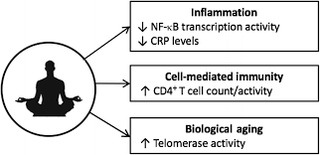Meditation
SARS-COV-19 – Part 7: Our mind can protect us from COV-19.
Meditation decreases inflammation and aging, increases immunity like exercise.
Posted September 3, 2020
We also need to attend to our own emotions as they affect our physical health and our immune system. Mindfulness meditation (MM) may help our mind not only deal with the stress of and anxiety over COV-19 but can help drive our immune system in a positive protective direction. MM is commonly defined as “the awareness that emerges through paying attention on purpose, in the present moment, and nonjudgmentally to the unfolding of experience moment by moment” (1). MM is readily available on the internet, downloadable apps, blogs, or websites (2) for use. It has also been defined as “a systematic attentional strategy to reduce cognitive vulnerability to reactive modes of the mind that might otherwise heighten stress and emotional distress” (1). Patients who have had COV-19, and their therapists relate that MM helped the patients be at one with their body so that they could meet their body where they were in their illness and its symptoms. This may seem counterintuitive, however, by nonjudgmentally reframing their anxiety, emotions, and thoughts, it seemed to keep them from making their symptoms worse. A systematic review of randomized controlled trials of MM and the immune system revealed benefits (fig 1).
The levels of NF-kB which coordinates the inflammatory response and CRP or c-reactive protein, a commonly used measure of inflammation are decreased. CD4+T lymphocytes (immune system white blood cells), protect the body against infection and promote tissue recovery. A decline in CD4+T lymphocytes is used as a “standard immune cell signal of disease progression in HIV patients” (1).
Immune cell telomeres are protective DNA and protein complexes that function as caps to protect and stabilize the ends of eukaryotic chromosomes, which truncate during cell division. Shortened telomeres are a marker of immature cell aging and vulnerability to apoptosis and are associated with poorer chemical outcomes and premature death in various age-related diseases. Telomere length is protected in part by the naturally occurring enzyme telomerase, which helps slow or reverse cell aging. Longer telomere and higher telomerase activity are thus considered to be salutogenic immune system profiles.
Figure 1: Mindfulness meditation and immune system biomarkers. This systematic review of 20 randomized controlled trials, comprising more than 1600 participants, revealed replicated, yet tentative, evidence that mindfulness meditation is associated with changes in select immune system processes involved in inflammation, immunity, and biological aging. These include decreased nuclear factor -xB (NF-xB) and C-reactive protein (CRP), increase CD4+ T cell count/activity and immune cell telomerase activity.

Metformin is commonly used to treat type two diabetes. It is also anti-inflammatory in diabetics and has anti-aging effects in animal models (3). It has also been found to decrease NF-kB (3, 4) and CRP (5). It increased autophagy in CD4+ T cells from older subjects and shifted measures of mitochondrial bioenergetics and T cell inflammation to values indistinguishable from young subjects’ cells (3). Metformin also reduces the hallmarks of aging by enhancing autophagy, delaying stem cell aging, modulating mitochondrial function, and lowering telomere attrition and senescence (6). Part of the benefits of MM that COV-19 patients and their therapists observed may in part be MM’s effects on immune system biomarkers and telomerase activity. It is possible that MM and metformin may beneficially augment each other not only in diabetes but in COVID-19 where CD4+ T cell mediated immunity leads the fight. Exercise can restore aged muscle stem cells’ ability to activate and repair tissue which lasted for one week after exercise ended (7). Similarly, moderate to higher levels of exercise can elevate telomerase activity and length (8). Moreover, a four-day self-paced moderate intensity exercise walk in physically fit elderly produced profound increases of naïve CD4+ T cells (9), which fight new infections such as COV-19, even in octogenarians (9). These results support the concept that the mind (MM) and the body (M and E) can work together to protect and heal us, even with COV-19.
References
1. Black, D. S., Slavich, G. M.: Mindfulness Meditation and the Immune System: A Systematic Review of Randomized Controlled Trials. Ann N Y Acad Sci 2016 Jun;1373(1):13-24. doi: 10.1111/nyas.12998.
2. WWW.THEMINDFULHEALTHFOUNDATION.COM
3. Bharath, L. P., Agrawal, M., McCambridge, G., et al.: Metformin Enhances Autophagy and Normalizes Mitochondrial Function to Alleviate Aging-Associated Inflammation. Cell Metab. 2020 Jul 7;32(1):44-55.e6. doi: 10.1016/j.cmet.2020.04.015.
4. Van den Bossche, J.: A brake on inflammaging Science Translational Medicine 27 May 2020: Vol. 12, Issue 545, eabb7104 DOI: 10.1126/scitranslmed.abb7104
5. Knowler, W. C., Barrett-Connor, E., Fowler, S. E., et al.: Reduction in the incidence of type 2 diabetes with lifestyle intervention or metformin N Engl J Med. 2002 Feb 7;346(6):393-403. doi: 10.1056/NEJMoa012512.
6. The Diabetes Prevention research group (Haffner, S., Temprosa, M., Crandall, J., et al.:) Intensive lifestyle intervention or metformin on inflammation and coagulation in participants with impaired glucose tolerance. Diabetes. 2005 May;54(5):1566-72. doi: 10.2337/diabetes.54.5.1566.
7. Aguilar, C. A.: Running makes old stem cells act young. 06 May 2020: Vol. 12, Issue 542, eabb7092 DOI:10.1126/scitranslmed.abb7092
8. Arsenis, N. C., You, T., Ogawa, E. F., et al.: Physical activity and telomere length: Impact of aging and potentialmechanisms of action. Oncotarget. 2017 Jul 4; 8(27): 45008–45019. doi: 10.18632/oncotarget.16726
9. Van der Geest, K. S M., Wang, Q., Eijsvogels, T. M H., et al.: Changes in peripheral immune cell numbers andfunctions in octogenarian walkers - an acute exercise study. Immun Ageing. 2017 Feb 22;14:5. doi: 10.1186/s12979-017-0087-2.


